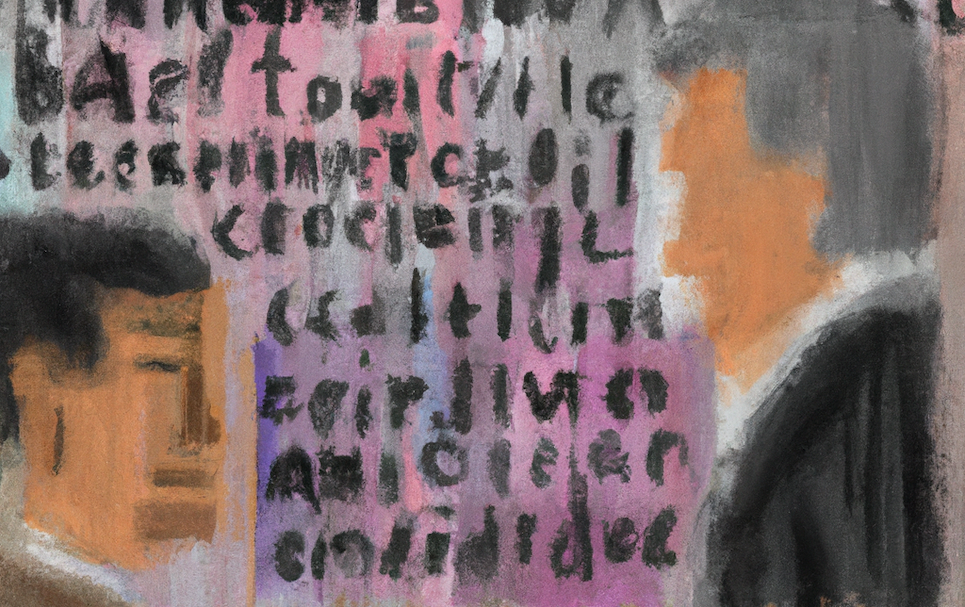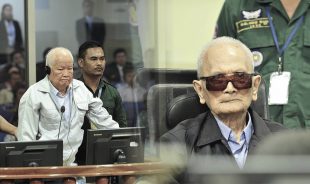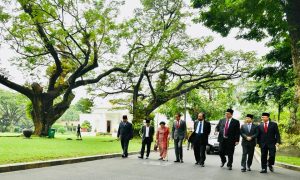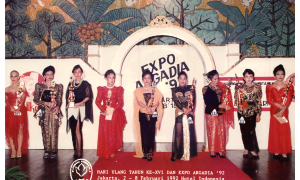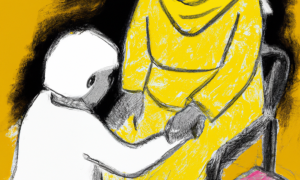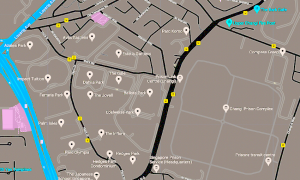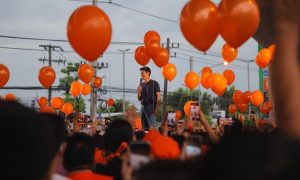In August 2015, roughly one year into the largest trial in the Extraordinary Chambers in the Courts of Cambodia (otherwise known as the Khmer Rouge Tribunal), a 61-year-old rice farmer named Chhum Seng took the stand. He was there to testify about life during the Democratic Kampuchea period (1975–1979) when Cambodia was ruled by the Communist Party of Kampuchea (CPK), better known as the Khmer Rouge.
During his testimony, Chhum Seng was questioned by the Cambodian and UN-appointed lawyers, enabled by simultaneous interpretation between the Court’s three working languages: English, French, and Khmer. At one point, the exchange turned to the fate of two men who had held leadership roles during the regime.
« Est-ce qu’il est arrivé quelque chose à Ta Maong, le chef de district de Preah Netr Preah, ainsi qu’à Ta Hat, chef de district de Phnum Srok, pendant que vous étiez sur le barrage de Trapeang Thma? » asked the French-speaking prosecutor, Vincent de Wilde. “Did something happen to Ta Moang, the head of Preah Netr Preah district, as well as to Ta Hat, the Phnum Srok district chief, while you were at the Trapeang Thma Dam site?”, repeated an interpreter for the benefit of the Anglophone judge, lawyers, and court-watchers, while another relayed the question to the witness in Khmer.
His reply was interpreted back to the Court as « À cette époque, c’est le moment où les cadres du Sud-Ouest sont arrivés. Ils ont tous été convoqués à une séance d’étude, mais je ne sais pas ce qui s’est passé par la suite » (“At that time, it was the time when the Southwest cadres arrived, and then they were all summoned to attend the education sessions. But what happened afterwards, I did not know.”)
« Est-ce que vous saviez ce que ça voulait dire être convoqué à une séance d’étude à l’époque? Est-ce que vous aviez compris ce que cela voulait dire?’, queried Mr de Wilde: “Did you know what being summoned to a study meeting meant back then? Did you understand what that meant?”.
« Lorsque l’Angkar les convoquait à une séance d’étude, cela voulait certainement dire qu’ils allaient être executes »—“The time when Angkar summoned them for an educational study session, that meant they were taken for execution for sure”, was the interpreted reply. That the witness’s reference to étude or “study” connoted murder was not immediately obvious, given that mandatory study sessions in the regime’s ultra-communist ideology were common during the Khmer Rouge years. But as Chhum Seng explained, the Khmer phrase yok tov rean (take away for study or learning) was also widely used as a euphemism to mean execution.
In this exchange, excerpted from our forthcoming article in the Cambridge Journal of International Law, we see some of the linguistic and culturally-specific communication challenges that characterised the Khmer Rouge Tribunal’s three trials. At every stage of the process (the investigations, the preparation of indictments, trials, sentencing, reparations awards, and appeals), communication was mediated by language professionals (i.e., translators and interpreters). Communication challenges arose across all stages of this process: sometimes triggered by the designated language of an international criminal tribunal, sometimes triggered by victims and witnesses’ use of euphemisms, idioms, and context-specific sayings, and sometimes by the inherent challenges associated with rendering words intelligible across languages.
A multilingual court
Linguistic challenges are, of course, not unique to the Khmer Rouge Tribunal. There is a large body of academic scholarship that explores challenges of translation and interpreting in legal proceedings, with work specifically considering language challenges in the context of prosecutions for international crimes: war crimes, crimes against humanity and genocide.
For example, challenges relating to culture-specific references have been documented in other international criminal trials, beginning with the International Military Tribunal in Nuremberg (1945–46) where the accuracy of interpretation of Nazi euphemistic jargon was debated, and recently, in the International Criminal Tribunal for the Former Yugoslavia (ICTY); International Criminal Tribunal for Rwanda (ICTR) and International Criminal Court (ICC).
Within domestic jurisdictions, communication challenges of a similar nature have been observed. Examples arose in the South Australian Supreme Court in 1992–1993 when Russian and Ukrainian witnesses gave evidence in the Australian war crimes proceedings against alleged Nazi collaborators accused of WWII-era atrocities in the former USSR. Witnesses, mostly from rural areas, provided culture-specific references embedded in the time and locations of events that took place 50 years prior and that appeared unclear in the modern Australian proceedings. When asked about the time of the day or the month of events, they referred to the position of the sun, the church services or the state of the crops in the field.
These are each examples of what one of us has termed “intercultural communication” gaps, meaning gaps that are not solely attributable to lexical and grammatical differences. These gaps arise because speakers of different languages often employ vastly different communication styles (e.g., more or less euphemistic, more or less literal, more or less concise).
While these challenges are common, there are features of the Khmer Rouge Tribunal that make it a particularly interesting example of a multilingual and multicultural court. Unlike the previously mentioned ICTY, ICTR and ICC, the Tribunal sat in the country where the crimes occurred, and roughly half its legal staff (and a majority of judges) are from that country also. Its use of Cambodian and international law and procedure, and its use of three working languages and two different scripts (the Latin alphabet and Âksâr Khmêr) have each shaped processes of translation and interpreting across languages and cultures.
The Nuon Chua and Khieu Samphan verdicts are likely a fitting end for the ECCC and its complicated legacy.
The end of the road for the Khmer Rouge tribunal
These institutional realities, combined with the challenges of translation and interpreting that have been documented in other war crimes tribunals, created a difficult environment for cross-linguistic and intercultural communication, raising questions around accuracy and fairness in the context of a complex international criminal process.
These questions form the basis for preliminary research being conducted by the authors—a group of Australia-based linguistic, interpreting, and legal researchers with a shared interest in the role of language professionals in legal proceedings. Here we share some initial observations at the linguistic and intercultural communication challenges that arose over the course of the Khmer Rouge Tribunal’s lifecycle, before flagging some issues we hope to explore in greater detail in the future.
Making legal terminology legible
Interpreting and translating legal terminology is a well-established challenge: concepts developed in one jurisdiction may have no obvious equivalent in another. This has been noted in a variety of contexts: at the ICTY, for example, translators and interpreters struggled to find French and Bosnian/Croatian/Serbian equivalents to a range of English-language concepts. ICTY interpreters are known to have used a variety of common interpreting/translation techniques, from loan words to paraphrase and explicitation to cultural equivalents, without an institutional norm having been established.
Building on the lessons of ICTY, the ICC used a terminology unit consisting of lawyers, linguists, and interpreters in African vernacular languages to coin new legal terms, including courtroom terms and stock phrases used in international law to overcome a lack of equivalents.
Similar challenges arose in Cambodia. While Khmer–English legal dictionaries have existed since the 1990s, the legal terminology associated with international criminal law and international fair trial standards raised new translation challenges. The fledgling state of Cambodia’s post-Khmer Rouge legal system likely exacerbated this challenge. As former Tribunal interpreter/translator Kok-Thay Eng has observed:
In the Khmer language, there is no consensus on legal terminology. I believe that in English, there is such consensus since modern laws have been widely practiced and concepts are written, discussed and used in many formats over and over. Therefore, interpreting legal speech from Khmer to English can be daunting because the original language might not be clear enough.
The need for accuracy in a legal process means that translators and interpreters may require additional training and resources to assist legal professionals. At the Khmer Rouge Tribunal, awareness of this need resulted in the creation of a Tribunal-specific glossary. This is described on the Tribunal’s website, where it is freely available, as reflecting “the Interpretation and Translation Unit’s collection, refinement, and standardisation of legal and non-legal terminology in Khmer, English, and French during court proceedings and investigations.”
The glossary contains over 12,000 terms, phrases, and names for use in both written translation and oral interpretation. This is no small task. As noted in other contexts above, finding consensus around terminology goes beyond linguistic translation, requiring interrogation of words and concepts’ diverse meanings and grappling with the fact that a literal translation does not always convey the same meaning in the other language. As Kok-Thay Eng described:
Interpretation from English to Khmer can also be difficult because the listeners in Khmer might not understand interpreted legal concepts. Of course, there are law dictionaries but in special cases, confusion can happen.
One example of a term that posed challenges of translation was “genocide”. As we have explored in greater detail elsewhere, the Khmer term for genocide used by the ECCC, prolai pouch-sas (ប្រល័យពូជសាសន៍), appears to align with the international definition of “genocide” as contained within the Genocide Convention. It can be translated as “to eliminate the lineage of a people or a nation”, “to eliminate the race (or the seed) of the nation”, and to “destroy from the root” or “kill the seed of the race”.
Yet in practice, prolai pouch-sas has historically been understood in much broader terms in Cambodia. While the Genocide Convention’s framing of genocide encompasses the targeting of particular national, ethnic, racial or religious groups with the specific intent of eliminating those groups, in Cambodia the term was and is used to describe crimes perpetrated, for any number of reasons, against the broader population. While the Khmer Rouge Tribunal ultimately stayed close to the Genocide Convention’s definition, dissenting views continued to be voiced throughout the Tribunal’s operation.
Translating euphemism
A second challenge arose around the frequent use of euphemism during investigations and trials. In part, this is a relic of Khmer Rouge times, during which violence was often described in veiled terms. A clear example can be seen in witness Chhum Seng’s use of the word “study” for “killing”, as described at the start of this post.
But witnesses and civil parties did not only use euphemisms to reflect speech patterns in Khmer Rouge times. They also reverted to euphemisms when it was difficult to speak directly about certain types of violence. For example, when talking about sexual violence, witnesses would use the word chab (ចាប់), which translates literally as “to catch, hold, touch, or arrest”, but which, for those familiar with the cultural context, implies forced sex or rape.
This tendency to use indirect language when describing sexual crimes is not unique to the Khmer Rouge Tribunal; it is common to many societies and cultures. International studies scholar Narelle Fletcher points to such a phenomenon in the context of Rwanda genocide atrocities, where, in the light of the lack of equivalent for “rape” in Kinyarwanda, victims and witnesses used euphemistic paraphrases such as gusambanya (“to bring [a person] to commit adultery or fornication”) and kuryamana (“to share a bed” or “to have sexual intercourse”, and the French loan word viol [rape]).
At the ICC, Sango interpreters, when interpreting testimonies of sexual violence in the Central African Republic, faced the lack of anatomical equivalents for genitals, with expletives being the only available equivalents. As one of us has explored, interpreters explained their choice to paraphrase and euphemise the lawyers’ use of anatomical terms in English or French (mon corps d’homme for penis, and mon corps de femme for vagina) by the fear that using expletives in Sango would discredit the lawyer in the eyes of the witnesses and make them lose faith in the lawyers’ professionalism.
For translators and interpreters, it is clear that euphemisms for killing, rape, and other acts of violence necessitate a difficult decision. To match, as far as possible, the ambiguity and indirect expression used by the witness? Or to substitute the witness’s phrase for something unambiguous? In our initial research with lawyers at the Khmer Rouge Tribunal, some expressed a preference that interpreters stay as close as possible to the witness’s word choice. This is seen as crucial from a legal perspective, because if the defendant is to be convicted based largely on witness testimony, it is imperative that the court knows precisely what those witnesses said, with minimal distortion, embellishment, or well-intended “clarification” from the interpreters.
In an ideal scenario, this would not result in meaning being lost in translation, provided that investigators, lawyers and judges are resourced with necessary training, and conscientiously do the work, to acquire the cultural and contextual knowledge that would prompt them to ask follow-up questions to the witness.
Our early research suggests that translators and interpreters at the Khmer Rouge Tribunal adopted different approaches when faced with this issue, and that investigators did not always know when to probe deeper. The implications of this are potentially serious: it may be that the omission of charges for sexual violence in the early stages of the investigation occurred in part because the English and French-speaking investigators were not as alert to euphemisms as they might have been, and therefore did not always ask questions that would have led to relevant evidence. However, the very nature of miscommunication means it is impossible to know how frequent or influential these miscommunications were.
Khmer Rouge jargon and forgotten histories
The final challenge we identified was interpreting and translating terms that can only be understood in their cultural and historical context. There are numerous words and phrases whose meaning was altered due to the way they were used during the Khmer Rouge regime, and that retain that meaning to victims and witnesses.
For example, there are a range of words associated with Marxist thought, which had been incorporated into the Khmer Rouge’s parlance from other political movements. The Khmer term sate-arem (សតិអារម្មណ៍), derived from Vietnamese tư tưởng/Chinese 思, for example, normally means something like “feelings, understanding, perception, memory”, but had the politically specific meaning of “ideology” during the Khmer Rouge regime.
For language professionals, these frequent encounters with Marxist–Leninist–Stalinist terminology necessitated a choice: whether to select English and French vocabulary that reflected the “Communist” meaning of the word, or whether to instead use words that reflected how the term would typically be understood by Khmer speakers today. With many of the language professionals lacking a background in Communist terminology, our research suggests that inconsistency arose around how key terms were translated.
Other examples arose in cases where terms had very historically specific meanings. Neak 17 Mesa (មនុស្ស ១៧ មេសា) or “17 April person(s)”, for example, was a common way of referring to someone who had been part of the forced evacuation of Phnom Penh on 17 April 1975. However, for younger language professionals, that meaning might not initially become clear. This lack of knowledge is understandable amongst younger language professionals: in a 2009 survey, the Human Rights Center at the University of Berkeley found that:
Nearly thirty years after the end of the Khmer Rouge regime, two-thirds of the population of Cambodia never directly experienced the violence and abuses of that period: 68 percent of the population is 29 years old or younger. Eighty-one percent of respondents in our survey who did not live under the Khmer Rouge regime described their knowledge of that period as poor or very poor.
In such cases, it again becomes important that professionals engaged in investigations, whether legal or language-focused, have the kind of contextual knowledge required to be able to identify where more specific questioning as to meaning might be required. As one of us has argued, challenges are dealt with more effectively in international courts and tribunals where lawyers and judges became familiar with the defendants’ and witnesses’ cultures.
Kok-Thay made a similar argument in his article about the Khmer Rouge Tribunal, observing that transcripts of victims often seemed incomplete or unclear, and “only people who are familiar with their stories can follow.” He suggested that interpreters:
should study the speech patterns of people who speak often at the ECCC. They should also study those people’s views, positions, and their frequently used terminologies. For example, they should study Duch’s case file, his biography, the way he speaks, the prison system and related legal terminologies for his particular case.
These suggestions, however, need to be considered carefully, taking into account the predominantly non-affiliated status of interpreters, a possible lack of access to relevant resources and the risk of inadequate institutional support for interpreters in terms of pre-trial preparations.
Regardless, the discussions here highlight the need for international criminal institutions to understand translation and interpreting as processes that go far beyond the simple conversion of words, and to consider the additional time and resources required to avoid significant facts being lost in translation. Some valuable lessons can be learned from the experience of international criminal courts and tribunals, such as the ICTY and the ICC, as well as from domestic prosecutions of atrocity crimes.
Questions for further research
There is much still to learn about the Khmer Rouge Tribunal’s experience of translation and interpreting. As a hybrid court operating across multiple legal and social cultures as well as three working languages, it offers a rich case study of how translation and interpreting “shapes” proceedings.
Over the course of our research, we hope to learn more about the effects of mistranslation and miscommunication on evidence, the process of interpreting euphemism and metaphor, the principles that guided translators and interpreters, the interactions between interpreters, translators and legal officers, how interpreting experiences of atrocity impacted those involved, and importantly, the lessons future multilingual courts, both domestic and international, could learn from the Tribunal’s experiences, and what the Tribunal offers to the growing rich literature on the role of language professionals in atrocity trials.
 Facebook
Facebook  Twitter
Twitter  Soundcloud
Soundcloud  Youtube
Youtube  Rss
Rss 